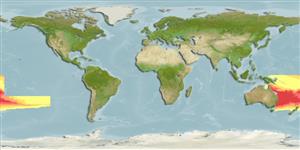Teleostei (teleosts) >
Gadiformes (Cods) >
Moridae (Morid cods)
Etymology: Physiculus: Diminutive of Greek, physa = tube.
Environment: milieu / climate zone / depth range / distribution range
Ecology
Marine; bathypelagic; depth range 83 - 610 m (Ref. 31777). Deep-water
Southwest Pacific: Australia, Bellona Plateau, New Caledonia, Kermadec Islands, New Zealand.
Size / Weight / Age
Maturity: Lm ? range ? - ? cm
Max length : 16.8 cm SL male/unsexed; (Ref. 31777)
A benthic species found on the continental shelf and slope (Ref. 75154).
Life cycle and mating behavior
Maturity | Reproduction | Spawning | Eggs | Fecundity | Larvae
Paulin, C.D. and C.D. Roberts, 1997. Review of the morid cods (Teleostei, Paracanthopterygii, Moridae) of New Caledonia, southwest Pacific Ocean, with description of a new species of Gadella. p. 17-41. In B. Séret (ed.) Résultats des Campagnes MUSORSTOM. Mem. Mus. Natl. Hist. Nat. (MMNHN), 174. (Ref. 31777)
IUCN Red List Status (Ref. 130435: Version 2024-1)
Threat to humans
Harmless
Human uses
Tools
Special reports
Download XML
Internet sources
Estimates based on models
Preferred temperature (Ref.
123201): 14.3 - 21.1, mean 18.7 °C (based on 32 cells).
Phylogenetic diversity index (Ref.
82804): PD
50 = 0.5000 [Uniqueness, from 0.5 = low to 2.0 = high].
Bayesian length-weight: a=0.01000 (0.00244 - 0.04107), b=3.04 (2.81 - 3.27), in cm total length, based on all LWR estimates for this body shape (Ref.
93245).
Trophic level (Ref.
69278): 3.4 ±0.4 se; based on size and trophs of closest relatives
Resilience (Ref.
120179): Medium, minimum population doubling time 1.4 - 4.4 years (Assuming tmax>3).
Fishing Vulnerability (Ref.
59153): Low vulnerability (11 of 100).
